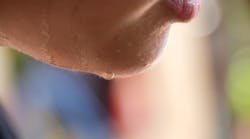Back in January, most dental professionals had never heard of COVID-19. Now not a day goes by when there aren’t dozens of discussions about our clinical upheaval. For the most part, the OSHA regulations for PPE are not new. They have been part of federal law since the AIDS/HIV epidemic cropped up decades ago, but over the years, many offices have not followed all of the requirements created for protection against blood-borne pathogens.
The new enemy is COVID-19. Health care workers are suiting up like never before to deal with the virus, and we’re all literally hot under the collar. Two weeks ago, I posted an on-line survey that took less than three minutes to complete. To date, over 2,800 dental health care workers have share their experiences. A new survey is being developed to capture information about health care workers, not just dental professionals.
No universal strategy—we’re all different
The current data set reveals dehydration and overheating are key problems facing clinicians. Of those who have returned to work, the majority are now experiencing 18 symptoms characteristic of dehydration or problems that point to a worker being overheated. As a writer, it is not typical for me to lead with solutions, but given today’s situation, we simply need to cool off and get hydrated. Forthcoming articles are in the works to address the physical impact of dehydration, oxygen deprivation, and other issues at a deeper level.
Everyone’s challenges are different. There is simply no one right strategy. And not everyone will embrace all of the suggestions. This is simply an opportunity to gather ideas that have worked for others faced with working in an overheated environment. Keep in mind that many of the strategies can be hidden under your gown or cap.
Gowns and undergarments
A variety of products are made from temperature-regulating materials. Most came out of the sporting or workout world. Over five years ago, Debra Carrier, RDH, created a uniform company from the ground up, called Twice As Nice Uniforms. Her portfolio of uniforms, lab coats, and scrub caps use special moisture-wicking technology to keep health care workers cooler. The newest addition is a gown with level 3 protection and is the only gown available today that features a collar. The factory is in New Jersey. All product components are also made in the United States.
There are clinicians who literally wear gowns over basic undergarments, t-shirts with mesh backs, or tank tops. Some simply changing gowns between patients in order to cool off and others are using products made from fabrics that claim to reduce body heat.
Keeping a cool head
While scientists have disproven the idea that we lose more heat from our head, most of us have never covered our hair for work, so now there is one more reason that we feel hot. Scrub caps or bouffant hair coverings come in all types of fabrics. Some find a larger size improves heat dissipation, others are donning damp caps, taking advantage of the cooling effect as the moisture evaporates. Some clinicians wet their hair before putting on a cap and allow Mother Nature to help them stay cool.
Gel chemistry, cooling towels, and wraps to the rescue
Reusable frozen gel packs have been around for years as post-surgical treatment options, provide comfort to nursing mothers, and help people deal with heat waves from hormone changes, chemotherapy, or certain medical conditions. Clinicians are putting frozen packs in their pockets, cleavage, or under their bra straps. Other cooling strategies include products disguised as necklaces with large cooling beads in the form of a long wrap.1,2 The reusable “beads” are gel packs that can be chilled over and over. Some headbands and neck wraps use evaporative technology to keep the user cool.
Cooling towels are another option. A wide variety of products are commercially available, and are made from polyvinyl acetate, microfiber, cotton or a combination of several chemistries, and the cooling mechanisms vary per product. Some use evaporation, while others use what is known as phase-changing technology where a removable pack, filled with saline or distilled water, can be frozen over and over. There are also pre-moistened towels that use natural ingredients like lime and lemon oil, aloe vera juice, and water to create an instant cooling sensation. A long-lasting cooling towel product can be draped around your neck and positioned under your gown.
Powders, natural chemistries, and skin softening strategies
Some clinicians find a dab of peppermint oil on the back of the neck creates a cooling sensation. Thermoreceptors in the skin detect a cooling sensation created by the menthol in peppermint. Topical application of peppermint oil generates a long-lasting cooling effect on the skin. 3
Body powders, formulated to absorb moisture, maintain a dry feeling. This is especially helpful in areas where clothing can cause chaffing. Basic cornstarch-based powders are popular. Some powders contain additional ingredients such as powdered slippery elm, ground cocoa butter, kaolin clay, arrowroot rice powder, tapioca starch or baking soda. Some products are labeled as vegan. There are also powder products that contain calamine to reduce skin friction. Some powders contain antifungal ingredients to reduce the risk of a fungal dermatitis outbreak.4
Clinicians are also adopting two other strategies to deal with excessive perspiration. Natural mineral ammonium salt sticks have been used for centuries as a natural deodorant that has antimicrobial and astringent properties. After washing, the hard stone is rubbed across the wet skin surface, then dry. While not specifically formulated for cooling, some use FiteBac, a silicone-based hand sanitizer, to create a smooth-feeling skin surface that resists chaffing. Since skin pathogens proliferate in warm, moist environments, FiteBac’s unique antimicrobial properties help kill microbes for up to four hours.
Keeping your cool
We need to stick together and learn from each other as we learn how to adapt to the new PPE requirements. The topic of keeping your cool can literally be approached from many different points of view. Remember these are merely tips and not intended to be medical strategies or solutions.
Ask your family and co-workers to watch out for your health and keep your eyes open to what is happening to others. Now is not the time to keep quiet or ignore what your body is telling you. If anything is amiss, please say something.
The next installment will focus on hydration strategies, dietary considerations, and environmental options.
Product resources
Cooling clothing
Cooling necklaces
Cooling vests
Ice packs
Powders, silicone gel, peppermint oil
- Lady Anti Monkey Butt powder
- Doterra peppermint essential oil
- FiteBac hand sanitizer
- Monistat Care Chafing Relief Powder Gel
Wraps, towels, vests
Uniforms
References
1.Mascarenhas N. Cool jewels — these necklaces help the wearer beat the heat. https://www.bostonglobe.com/business/2017/07/16/cool-jewels-these-necklace-help-weater-beat-heat/ZKZ7VOUWxuRQBvlBe70tSP/story.html. Accessed 6/23/2020.
2. Make your own funky reusable cooling necklace. https://snottydog.wordpress.com/2012/08/28/make-your-own-funky-reusable-cooling-necklace/. Accessed 6/23/2020.
3. Göbel H, Schmidt G, Dworschak M, Stolze H, Heuss D. Essential plant oils and headache mechanisms. Phytomedicine. 1995;2(2):93-102. doi:10.1016/S0944-7113(11)80053-X
4. Leyden JJ. Corn starch, Candida albicans, and diaper rash. Pediatr Dermatol. 1984;1(4):322-325. doi:10.1111/j.1525-1470.1984.tb01138.x
Anne Nugent Guignon, MPH, RDH, CSP, provides popular programs, including topics on biofilms, power driven scaling, ergonomics, hypersensitivity, and remineralization. Recipient of the 2004 Mentor of the Year Award and the 2009 ADHA Irene Newman Award, Anne has practiced clinical dental hygiene in Houston since 1971, and can be contacted at [email protected].







